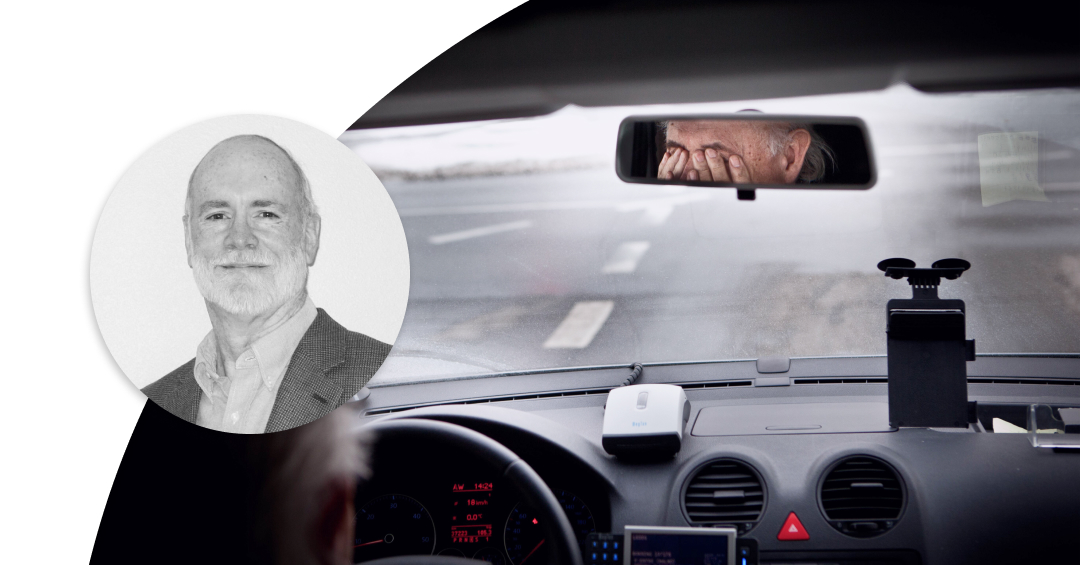Distracted Driving Awareness Month: considering crashes and climate

In the United States, April is recognized as Distracted Driving Awareness Month. An initiative by the country’s National Safety Council, the aim is to raise awareness and motivate drivers to change their attitudes about distracted driving.
At Greater Than, we’re pleased to support efforts to reduce road crashes and have chosen to join the conversation around Distracted Driving Awareness Month by taking a wider view of distracted driving to highlight its impact on both crash probability and climate impact.
What exactly is distracted driving?
Distraction is commonly associated with mobile phones, but there are many types of distraction. Even daydreaming is a common form of driver distraction. It may seem harmless, but anything that takes the mind away from the driving task increases crash probability.
In today’s modern world, with many people juggling work commitments and personal responsibilities, the concept of “multitasking” behind the wheel is a familiar one. However, brain science has proven that multitasking is a myth. In reality, research shows what actually is happening when you think you are multitasking is the brain is rapidly switching between tasks, usually to the detriment of all tasks. One driving simulator study even found that only 2.5% of participants experienced no impact on performance when undertaking dual tasks[i].
Why focus and attention matter for safe driving
Driving is a complex task. To be done safely, it involves managing several vehicle controls, while also checking mirrors, looking well ahead, scanning the environment, and anticipating the actions of others.
With so many responsibilities while driving, it’s easy to see how distraction can influence crash probability. This is especially true of tasks that take your eyes off the road. The United States Department of Transportation (USDOT) says it takes about five seconds to read a text, and at 55mph (88kph) this could be compared with driving the length of a football field!
Distracted driving and the environment
One of the fastest growing pressures on companies today is sustainability. Included within the sustainability umbrella is the shift to mandatory Environmental, Social and Governance (ESG) reporting. Distracted driving is not very often given prominence within the sustainability/ESG agenda. Yet it directly relates to it.
Here are a couple of examples. Looking well ahead while driving helps the driver to anticipate what’s coming up, enabling them to adjust speed slowly and steadily. Distracted driving affects this skill and can result in uneven speed control including harsh braking and acceleration. In turn, this is likely to increase fuel consumption and CO2 emissions. Similarly, a distracted driver is less aware of their environment generally, and therefore less aware of the flow of traffic. Most of us will have seen drivers increasing and decreasing speed unnecessarily while using their phones. Again, this impacts fuel consumption and CO2 emissions.
Who can make a difference in distracted driving?
Of course, the driver is the one in control of their attitude and behavior and ultimately the one responsible for their own crash probability and climate impact. However, organizations play a significant role in influencing driving behaviors.
Fleets, for example, can implement policies and safety programs that require focus. No Phone Use While Driving policies as well as companywide awareness campaigns have been shown to be extremely effective at reducing instances of distracted driving. Telematics companies can also play a role in incentivizing safer driving. By working with fleet customers to uncover risk insights, they can identify drivers in need of risk intervention. Insurance companies, too, can be instrumental in reducing distracted driving. For example, insurance companies that introduce a behavior-based approach to premiums can reward safe behavior and increase prices for higher-risk drivers, helping to incentivize low-risk, distraction-free behaviors.
Uncovering crash probability and climate impact
At Greater Than, we enable all owners of GPS data to convert their driving data into scores that predict crash probability and climate impact, using the power of artificial intelligence (AI). Our Crash Probability Score not only identifies crash likelihood, but can also give insights into the reasons behind it, including lack of focus and attention.
Our Climate Impact Score identifies the correlation between driver attitude and energy consumption, demonstrating how focus and anticipation directly correspond with environmental impact.
It’s easy to uncover new insights to support distracted driving initiatives
GPS data is all that’s needed to get started with Greater Than’s AI – and this can be obtained via a simple API connection.
Once a company connects to our platform, our AI processes and analyzes every trip against billions of previous real-world trips. This identifies patterns in driving behavior and provides insight into crash probability and climate impact. The analyzed data can be pushed to a company’s existing fleet management system, a driver app, SDK or visualized via one of Greater Than’s add-on solutions.
Contact Greater Than or book a meeting with me to discover how our AI can support efforts to identify and reduce distracted driving.
[i] (PDF) Supertaskers: Profiles in extraordinary multitasking ability

